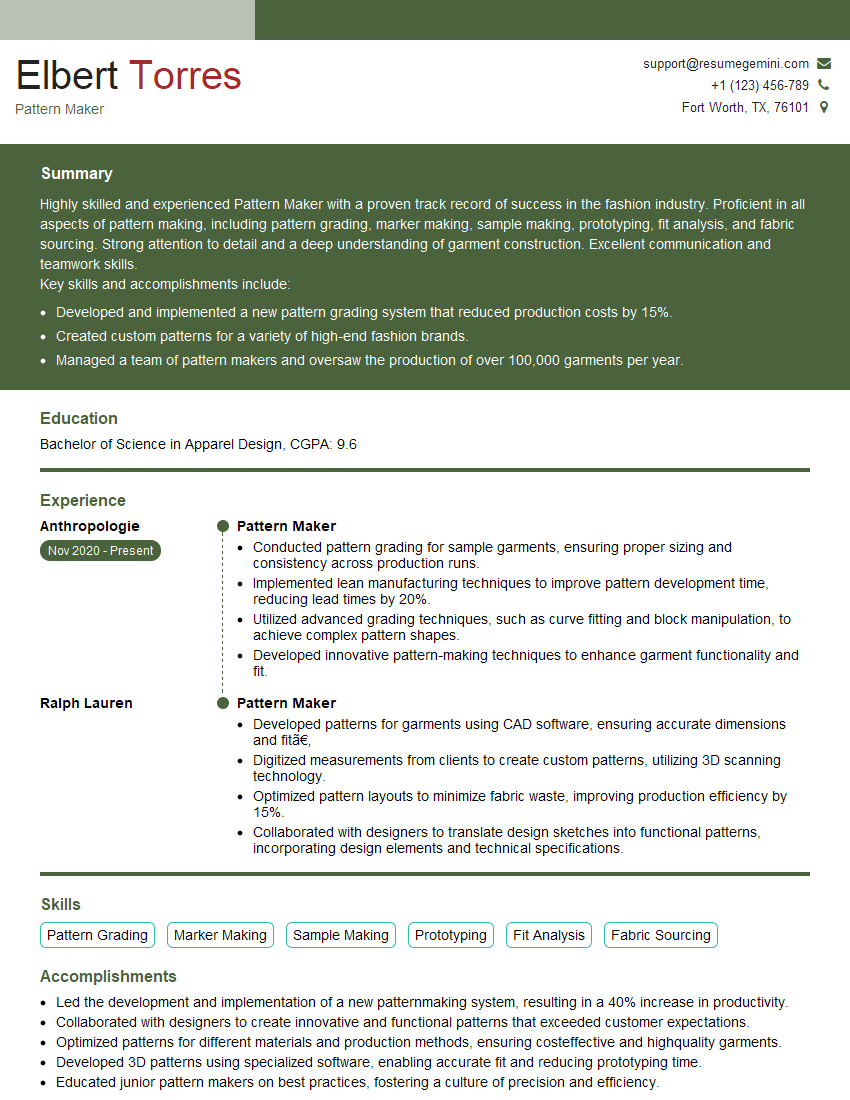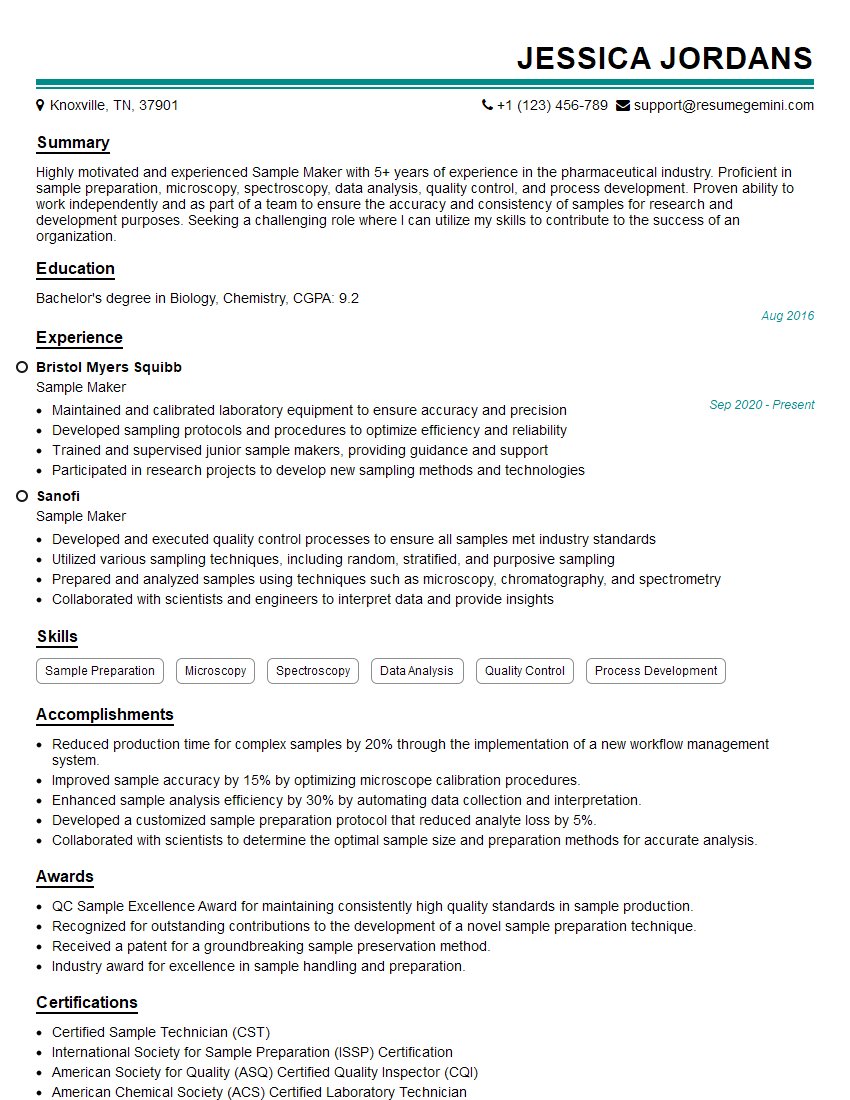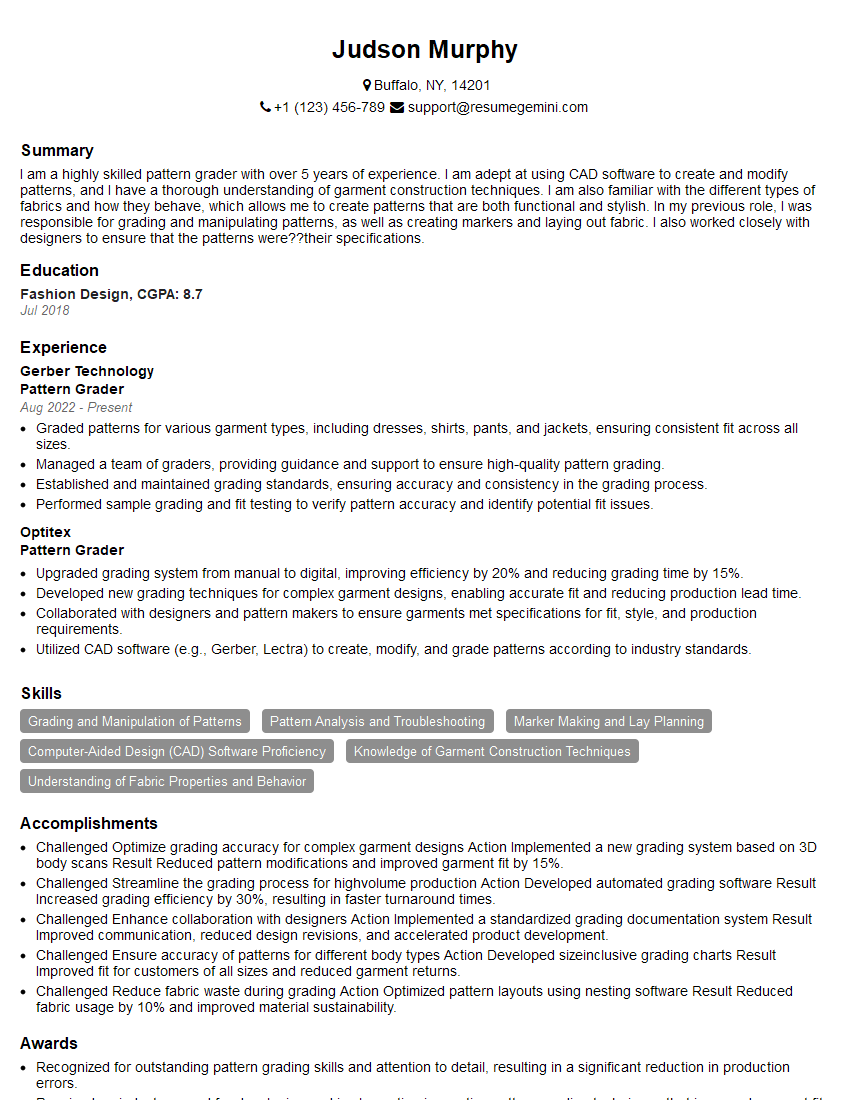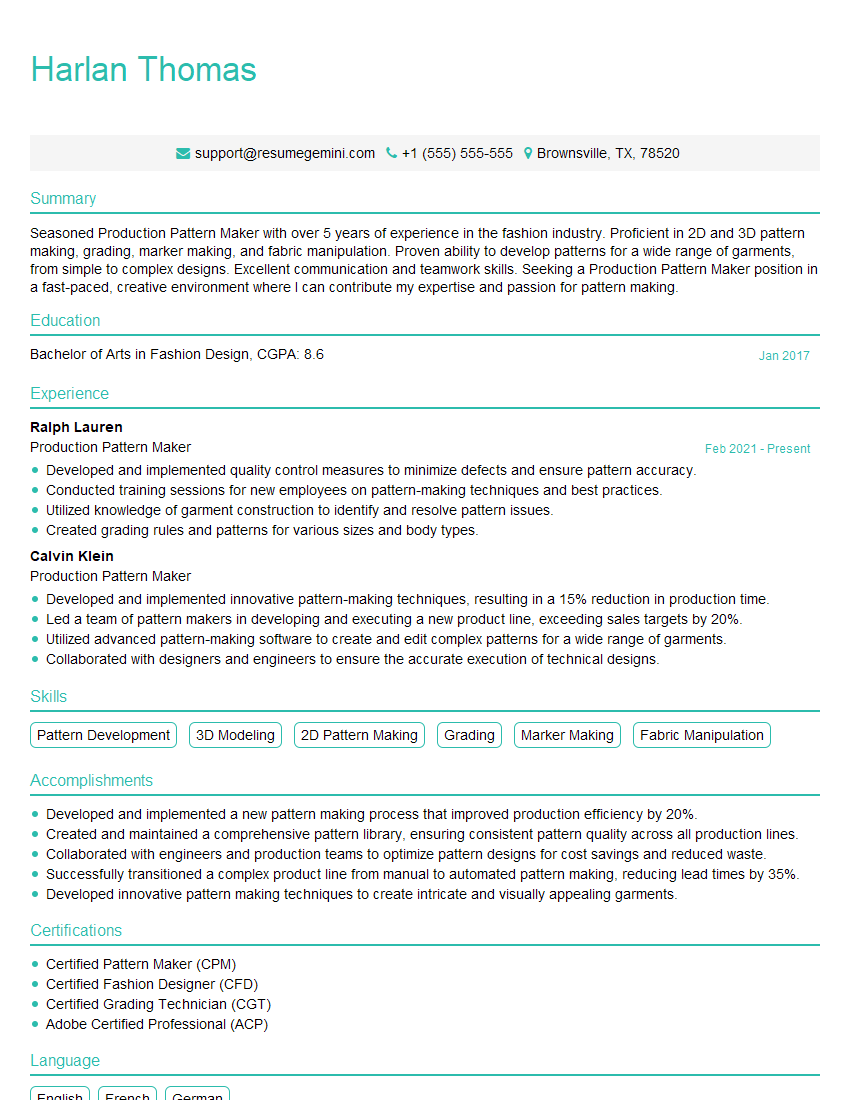Interviews are opportunities to demonstrate your expertise, and this guide is here to help you shine. Explore the essential Pattern Grading and Alterations interview questions that employers frequently ask, paired with strategies for crafting responses that set you apart from the competition.
Questions Asked in Pattern Grading and Alterations Interview
Q 1. Explain the difference between pattern grading and pattern making.
Pattern making and pattern grading are distinct but interconnected processes in apparel design. Pattern making is the initial creation of a base pattern, a two-dimensional representation of a garment designed for a specific size. This involves drafting the pattern from measurements or draping fabric on a dress form. Pattern grading, on the other hand, is the process of systematically adjusting this base pattern to create a range of sizes, from smaller to larger. Think of it like baking a cake – pattern making is creating the original recipe, and grading is adapting that recipe to make different sized cakes, ensuring each retains its shape and proportions.
For instance, a pattern maker might create a size medium shirt pattern. A grader would then systematically increase or decrease the measurements of that pattern to create small, large, extra-large, and so on, maintaining the design’s aesthetic integrity across all sizes.
Q 2. Describe your experience with various grading systems (e.g., manual, computer-aided).
My experience encompasses both manual and computer-aided grading systems. Manual grading involves using tools like rulers, curves, and grading scales to physically adjust pattern pieces. This method allows for a nuanced understanding of the pattern and offers flexibility for complex adjustments. However, it’s time-consuming and prone to human error. I’ve worked extensively with this method, honing my skills in precise measurement and consistent adjustments.
Computer-aided grading (CAG) software, on the other hand, automates much of this process. I’m proficient in several leading CAG programs, such as [Mention specific software, e.g., Optitex, Gerber Accumark]. These systems significantly improve efficiency and accuracy. Using these tools, I can input grading rules and the software will automatically adjust the pattern pieces. This not only saves time but also minimizes inconsistencies across sizes. I find that combining the knowledge and precision of manual grading with the efficiency of CAG software results in the best possible outcome.
Q 3. How do you handle inconsistencies in grading across different sizes?
Inconsistencies in grading can arise from various sources, including inaccurate initial measurements, faulty grading rules, or even errors in the software itself. My approach involves a multi-step process to identify and rectify these inconsistencies. First, I meticulously compare graded patterns across sizes, looking for any discrepancies in proportions or balance. A visual inspection often reveals subtle issues. I then perform detailed measurements, checking crucial points such as sleeve length, neckline depth, and garment circumference. Any deviations from expected proportions are flagged and investigated. If the discrepancies are due to incorrect grading rules, I correct them in the software. If they are caused by human error in either manual or CAG processes, I adjust the patterns using a combination of manual techniques and software features to ensure consistency. This iterative process, combining visual analysis with precise measurement, is key to achieving consistent grading across all sizes.
Q 4. Explain your process for adjusting a pattern for different body types.
Adjusting patterns for different body types requires a thorough understanding of body shapes and how they impact garment fit. I begin by identifying the specific needs of the target body type. For instance, a pattern designed for a straight body shape might need adjustments for a curvy figure, such as adding fullness to the bust and hip areas. The process involves making adjustments at key points on the pattern, such as the bust, waist, and hip. These adjustments might include adding or removing darts, easing curves, or modifying seam allowances. I often use slopers (basic block patterns) as a starting point, which are then customized based on the specific body shape and size. Techniques like pivot points and control points are applied to ensure the changes maintain the overall balance and aesthetics of the design. I also rely on fit models representing different body types to test and refine these adjustments during the process, ensuring a comfortable and flattering fit.
Q 5. Describe your experience with different types of fabrics and how they affect grading.
Fabric type significantly affects the grading process. Different fabrics have varying degrees of drape, stretch, and thickness, which can impact how a pattern behaves when sewn. For example, a tightly woven fabric like linen might require less ease (the extra fabric added for comfort and movement) than a drapey fabric like silk. Similarly, a stretchy knit fabric may need different grading rules than a non-stretch woven fabric. I account for these differences by adjusting grading rules based on the fabric’s properties. I might add or reduce ease to accommodate the fabric’s drape, adjust seam allowances for stretch, or make modifications to ease points to achieve a desired fit. In practice, I often create separate grading specifications for different fabric types, preventing inconsistencies and ensuring the final garment fits appropriately regardless of the fabric selected.
Q 6. How do you ensure accuracy in your grading measurements?
Accuracy in grading measurements is paramount. I employ several techniques to ensure precision. First, I always use calibrated measuring tools, regularly checked for accuracy. Second, I use consistent measurement methods, adhering to standard industry practices. Third, when grading manually, I use tools such as French curves and grading rulers for smooth and precise adjustments. Fourth, when using CAG software, I verify the accuracy of the grading rules by checking the measurements on the graded patterns. A double-check system is vital. This involves comparing digital measurements with manual measurements taken from the physical pattern pieces, reducing the potential for error in automated processes. Finally, I regularly test the graded patterns by creating samples to identify and rectify any fit issues before mass production, ensuring high accuracy and reliable results.
Q 7. What software are you proficient in for pattern grading?
My proficiency includes several leading pattern grading software packages. I’m highly experienced with [Mention Specific Software, e.g., Gerber Accumark, Optitex, Lectra Modaris]. I’m also comfortable with [Mention other relevant software, e.g., Adobe Illustrator for pattern manipulation and illustration] to enhance pattern design and quality control. My knowledge encompasses both the technical aspects of using the software and the theoretical understanding of grading principles, allowing me to optimize software features to effectively address the demands of varying grading projects.
Q 8. How do you identify and correct pattern fitting issues?
Identifying and correcting pattern fitting issues involves a systematic approach. First, I meticulously analyze the muslin or test garment, noting areas of pulling, gaping, or excess fabric. This visual assessment is crucial. I then consider the body measurements and compare them to the pattern measurements to identify discrepancies. For example, if the bust area is pulling, it indicates the pattern is too small in the bust. Conversely, gaping suggests the pattern is too large.
Correction methods depend on the specific issue. For pulling, I’d consider adding a seam allowance adjustment, perhaps by adding a small amount of width at the bust. If the problem is more complex, such as excessive pulling across the back, it could necessitate a full back adjustment, potentially involving a swayback adjustment. For gaping, I’d reduce the seam allowance or even make adjustments to the pattern pieces themselves.
Tools like pattern-making software can aid in making precise adjustments, but a keen eye and hands-on experience are essential for making effective changes. I always test my corrections with a new muslin before proceeding to the final garment.
Q 9. What are the key considerations when grading a pattern for plus sizes?
Grading for plus sizes requires careful consideration of the body’s changes in proportion. It’s not just about increasing the numerical size; it’s about understanding how the body shape changes. This means adjusting ease differently. For instance, across the bust, back, and hip areas, more ease is needed for comfort and a flattering fit.
Key considerations include:
- Proportional Grading: Simply increasing all measurements proportionally often leads to an ill-fitting garment. Certain areas, like the shoulder width and back width, may not increase proportionally to the bust. Careful analysis and adjustments are crucial.
- Ease Adjustment: Plus-size garments often require more ease to accommodate different body shapes and sizes. Understanding the difference between design ease, fitting ease, and comfort ease is crucial.
- Dart Manipulation: Darts may need to be moved or their depth adjusted to maintain a good fit. In larger sizes, darts may not be as effective, so sometimes design features like princess seams are more suitable.
- Fabric Considerations: Fabric drape and stretch influence the fit dramatically. Heavier fabrics might require adjustments to ease and drape.
Imagine grading a simple bodice: simply increasing the numerical size may lead to a garment with a poorly shaped neckline and awkward fitting sleeves. Understanding how to adjust the proportions across the entire pattern is key to a successful plus-size grade.
Q 10. How do you deal with complex design details during grading?
Complex design details present unique challenges in grading. For instance, consider a dress with intricate seaming, such as a fitted bodice with princess seams and a gathered skirt. Grading this involves maintaining the design aesthetic while ensuring proper fit across all sizes. It’s a balance of precise numerical adjustments and maintaining the original design intent.
My approach involves breaking down complex designs into smaller, manageable sections. I grade each section individually, paying close attention to how adjustments in one area will affect others. For example, changing the curve of a princess seam will impact both the bust and waist fit. I often create separate slopers for individual components and then combine them after grading. This allows for more control and precision.
Digital pattern making software significantly aids in handling these complexities by allowing for precise alterations and visual verification before printing the graded pattern. Testing the fit of each component is essential before assembling them.
Q 11. Explain your experience with grading different garment types (e.g., dresses, pants, jackets).
My experience encompasses a wide range of garment types. I have extensive expertise in grading dresses, pants, and jackets. Grading dresses often involves dealing with complex shapes like princess seams, yokes, and darts. Pants grading necessitates accurate adjustment to the crotch curve, waistline, and hip circumference, ensuring comfortable fit and proper drape. Jacket grading requires attention to fitting across the shoulders, chest, armscyes, and back, considering details like collars, lapels, and pockets.
For example, I recently graded a line of tailored jackets, meticulously adjusting the shoulder slope, armhole depth, and back width to ensure a flattering silhouette across different sizes. Each garment type presents unique grading challenges; however, a solid understanding of body proportions and construction techniques is key to successful grading regardless of the garment type.
Q 12. How do you manage multiple grading projects simultaneously?
Managing multiple grading projects simultaneously requires a structured and organized approach. I utilize project management tools to prioritize tasks and track deadlines. Each project has a dedicated file system and a detailed grading plan that outlines specific adjustments for each size.
Prioritization is key. I often tackle the most time-sensitive projects first, breaking them into smaller, manageable tasks. Utilizing grading software with efficient organization and labeling tools further enhances my ability to seamlessly move between projects. Regular progress checks and communication with clients keep everyone informed and prevent delays.
Q 13. Describe your quality control process for graded patterns.
My quality control process is rigorous and involves several steps. First, I perform a thorough visual check of the graded patterns, comparing them to the original pattern and ensuring the adjustments are consistent and logical. This involves checking for any distortion or inconsistencies in the shape of the pattern pieces.
Then, I create a muslin or a test garment in the graded size to check the actual fit on a form or model. Any necessary corrections are made at this stage. Finally, I measure the muslin thoroughly to verify that the measurements align with the intended size. This systematic check ensures a high-quality end-product and reduces errors in the production process.
Q 14. What are the common challenges encountered in pattern grading?
Common challenges in pattern grading include:
- Maintaining Design Integrity: Grading should not compromise the original design’s aesthetic appeal.
- Dealing with Complex Designs: Intricate details, such as princess seams or curved lines, require careful consideration.
- Variations in Fabric: Different fabrics drape and stretch differently, necessitating adjustments to the grading.
- Body Shape Variations: Bodies are diverse; accurately grading patterns for various body shapes and sizes can be challenging.
- Time Management: Grading multiple patterns simultaneously requires efficient organization and prioritization.
Overcoming these challenges requires a blend of technical skills, a creative approach, and the ability to adapt to various situations. Continuous learning and a keen eye for detail are essential for producing high-quality graded patterns.
Q 15. How do you stay updated with the latest industry trends in pattern grading?
Staying current in pattern grading requires a multi-pronged approach. It’s not just about the latest software; it’s about understanding evolving design aesthetics and body-shape considerations. I actively participate in industry conferences and workshops, such as those hosted by the Apparel Search or similar organizations. This allows me to network with other professionals and learn about innovative techniques and new technologies. I also subscribe to relevant trade publications and online journals focusing on apparel design and manufacturing. Finally, I dedicate time to researching advancements in pattern-making software and CAD systems, experimenting with new features to enhance my efficiency and accuracy. For instance, recently I’ve been exploring the use of 3D body scanning data integration into my grading workflows for a more precise and customized fit.
Career Expert Tips:
- Ace those interviews! Prepare effectively by reviewing the Top 50 Most Common Interview Questions on ResumeGemini.
- Navigate your job search with confidence! Explore a wide range of Career Tips on ResumeGemini. Learn about common challenges and recommendations to overcome them.
- Craft the perfect resume! Master the Art of Resume Writing with ResumeGemini’s guide. Showcase your unique qualifications and achievements effectively.
- Don’t miss out on holiday savings! Build your dream resume with ResumeGemini’s ATS optimized templates.
Q 16. How do you communicate grading specifications to others?
Clear and precise communication is paramount in pattern grading. I utilize a combination of methods to ensure everyone understands the specifications. This starts with detailed, well-organized grading specifications documents. These documents include a comprehensive list of measurements for each size, clearly specifying the increments and methods for grading (e.g., linear, proportional, or curve-based). I use visual aids such as annotated pattern pieces, highlighting the areas that require grading adjustments, and providing visual examples of the expected outcome. We also utilize collaborative software that allows for real-time feedback and version control. Moreover, I conduct regular team meetings to discuss any ambiguities or challenges and ensure everyone’s alignment on the process and expected results. For instance, if there’s a complex curve adjustment, I’ll create a small-scale physical mock-up to demonstrate the desired outcome.
Q 17. What are the key measurements to consider when grading a pattern?
The key measurements when grading a pattern depend on the garment type, but generally include:
- Body measurements: These are the foundation. We use a standard size chart as a starting point and consider crucial measurements like chest circumference, waist circumference, hip circumference, back width, shoulder width, sleeve length, and inseam (for pants). The accuracy of these measurements is critical.
- Pattern measurements: These are the measurements taken directly from the base pattern. Comparing these to the body measurements helps identify areas that need adjustments. This includes all the critical seams and points, such as bust point, waist point, and shoulder point.
- Ease: This is the extra fabric added for comfort and fit. It’s essential to maintain consistent ease across all sizes to ensure a comfortable garment in each size.
- Grading increments: These are the amounts by which measurements are increased or decreased from one size to the next. These are usually determined based on industry standards or specific brand requirements. A properly constructed grading specification clearly defines these increments for all relevant measurements.
For example, if grading a shirt pattern, accurate grading of the chest circumference, shoulder width and sleeve length are paramount for ensuring a proper fit across all sizes.
Q 18. Explain the importance of maintaining accurate grading records.
Maintaining accurate grading records is crucial for several reasons. First, it ensures consistency. If a pattern needs to be reproduced or altered later, the original grading information is readily available to reproduce the exact specifications. Second, it facilitates error tracking. If there’s an issue with a particular size, the records help pinpoint where the problem originated, allowing for corrections and avoiding repetition. Third, it’s essential for legal and manufacturing reasons; documented grading records show a clear production process and accountability. In my workflow, I use a digital database to maintain a detailed record of all grading specifications, including date, garment name, size range, and any notes or revisions. Version control is extremely important. Each version is stored with a unique identifier and a change log noting modifications. This helps in tracing back to older versions, identifying the source of inconsistencies and facilitating better analysis and decision-making.
Q 19. How do you handle revisions or corrections to a graded pattern?
Handling revisions is a common part of the pattern grading process. When revisions or corrections are needed, I first carefully analyze the feedback or the reason for the correction. This often involves revisiting the original pattern and the grading specifications. I would then make the necessary adjustments to the pattern pieces digitally and meticulously document all changes in the grading records, including date, nature of the revision, and who approved the changes. Crucially, any revised pattern pieces are clearly marked and labeled to distinguish them from previous versions. We use a version control system to manage revisions, ensuring that all team members have access to the latest version and can trace changes throughout the process. A new sample garment would usually be made to evaluate the efficacy of these revisions.
Q 20. Describe your approach to solving a difficult grading problem.
A systematic approach is key to solving difficult grading problems. I start by thoroughly analyzing the problem, identifying the specific area of difficulty. This might involve comparing the graded pattern to a physical sample to pinpoint discrepancies. Then, I break down the problem into smaller, manageable parts. For example, if the fit is problematic in the sleeve cap, I’d focus solely on that area, making incremental adjustments and testing each change until the fit is satisfactory. This might involve reviewing the original base pattern, checking ease calculations, and adjusting grading increments in specific areas. I frequently use draping techniques to help resolve complex fit issues, especially in areas with curved seams. Once a solution is found, I document it meticulously, including details on the adjustments and the reasoning behind them. Collaboration is also crucial. Consulting with other experienced graders or pattern makers can provide fresh perspectives and help identify potential solutions I might have overlooked.
Q 21. What are your strategies for efficiently grading large volumes of patterns?
Efficiently grading large volumes of patterns necessitates leveraging technology and optimizing workflows. I rely heavily on CAD (Computer-Aided Design) software with grading capabilities. These programs automate many of the repetitive tasks, significantly speeding up the process. In addition, I develop and utilize grading rules and templates based on style and brand standards. This allows for consistent application of grading rules for similar styles and significantly streamlines the process. Moreover, I prioritize automation where feasible and use batch processing techniques within the CAD software for grading multiple patterns simultaneously. Effective time management also plays a crucial role. I break down large projects into smaller, manageable tasks, setting deadlines and prioritizing based on urgency and importance. For example, I might separate grading by garment type or size range to enhance efficiency. Regular quality checks are integrated throughout the process to maintain accuracy and spot any potential issues early on.
Q 22. How familiar are you with different grading methods (e.g., proportional grading, incremental grading)?
Pattern grading is the process of scaling a base pattern to create different sizes. Two common methods are proportional and incremental grading. Proportional grading uses a consistent percentage increase or decrease across all pattern pieces, assuming a uniform body shape change across sizes. This is a simpler, faster method, suitable for basic garments or when exact fit isn’t paramount. Incremental grading, on the other hand, uses specific measurements for each size, allowing for more precise adjustments to accommodate differing body proportions. This approach requires more detailed knowledge of body shapes and is often preferred for tailored garments where fit is crucial.
For example, a proportional grading method might increase sleeve length by 1/2 inch for each size increase. Incremental grading would consider varying sleeve cap heights and armhole depths which might require larger increases in some areas than others for a proper fit for larger sizes. The choice depends on the garment’s complexity and the required level of accuracy.
Q 23. Describe your experience with altering garments to improve fit.
My experience in garment alteration encompasses a wide range of projects, from simple adjustments like shortening sleeves or hemming pants to more complex alterations involving significant reshaping and reconstruction. I’ve worked with diverse fabrics and garment styles, adapting my techniques accordingly. A recent example involved completely altering a wedding dress that was too large in the bodice and hips. I used a combination of dart manipulation, seam adjustments, and the addition of new fabric panels to achieve a perfect fit, resulting in a very happy customer. My experience includes working on both ready-to-wear garments and custom-made pieces.
Q 24. How do you determine the necessary alterations based on a customer’s body measurements and the garment fit?
Determining necessary alterations begins with a thorough assessment of the garment’s fit against the customer’s body measurements. I take detailed measurements of the customer and then compare those measurements to the garment’s measurements. Discrepancies highlight areas needing adjustment. For instance, if the customer’s bust measurement is significantly larger than the garment’s, I’ll need to let out seams or add fabric to the bodice. This requires a keen eye to identify whether the issue is just overall sizing, or whether it’s a more complex fit problem, such as needing shoulder adjustments or altering the waistline’s placement. Accurate measurements and a clear understanding of the garment’s construction are essential to plan the alterations successfully.
Q 25. What are your techniques for altering various types of garments (e.g., dresses, pants, shirts)?
My techniques for altering different garment types are tailored to their specific construction. For dresses, alterations might involve adjusting darts, princess seams, or side seams to accommodate the body shape. Pants alterations often focus on adjusting the waist, hip, and inseam. This can involve taking in or letting out seams, or more complex adjustments like tapering the legs or reshaping the seat. Shirt alterations frequently involve adjusting the shoulders, sleeves, and chest. I might need to manipulate sleeve caps or ease in excess fabric at the shoulder seams. Each garment type presents unique challenges and requires a nuanced understanding of its structure to execute alterations effectively and maintain the garment’s original design aesthetic.
Q 26. What types of tools and equipment are you familiar with for alterations?
I’m proficient with a variety of tools and equipment for alterations. This includes sewing machines (both industrial and domestic), sergers, shears, measuring tapes, seam rippers, tracing wheels, tailor’s chalk, pattern weights, dress forms (both adjustable and standard), and pressing equipment like irons and steam presses. I also utilize specialized tools such as ease adjusters and curve rulers for precise adjustments to curves in patterns and garments. The choice of tools depends on the type of alteration, the garment’s fabric, and the desired finish. Proper tool selection contributes significantly to achieving professional results.
Q 27. How do you address complex fitting problems during alterations?
Addressing complex fitting problems requires a systematic approach. I begin by pin-fitting the garment on the customer to identify the precise areas needing adjustment. This allows for a visual assessment of the problem and helps to determine the best course of action. For instance, a garment that is too tight across the shoulders might require a combination of letting out shoulder seams, adjusting the armhole, and potentially even reshaping the neckline. I always document my work and keep records of adjustments made. This ensures that if further adjustments are necessary, I have a clear understanding of what has already been done, which prevents undoing good work or repeating previous mistakes.
Q 28. How do you communicate with customers about their garment alterations?
Clear and open communication is vital. I begin by discussing the customer’s expectations and the garment’s limitations with them, being transparent about what can be achieved and setting realistic expectations regarding the timeline and cost. I actively listen to their concerns and provide them with detailed explanations of the proposed alterations, showing them precisely how I intend to make the adjustments. I make sure to get their approval at each stage of the alteration process before proceeding. I also maintain open communication channels, providing timely updates, answering their questions, and addressing any concerns throughout the process. This builds trust and ensures a positive experience for the customer.
Key Topics to Learn for Pattern Grading and Alterations Interview
- Understanding Basic Pattern Construction: Knowing the fundamental elements of a sloper and how different pattern pieces interact is crucial. This includes understanding seam allowances, grainlines, and marking symbols.
- Grading Techniques: Mastering both manual and digital grading methods, including understanding the principles of proportional grading and the use of grading software.
- Alteration Principles: A thorough understanding of common body variations and how to adjust patterns to accommodate them, such as fitting adjustments for bust, waist, and hip. This includes understanding ease and fit.
- Fabric Considerations: Knowing how different fabric types (knits vs. wovens, stretch vs. non-stretch) affect pattern grading and alteration techniques. Understanding drape and handling is key.
- Practical Application: Experience with real-world pattern adjustments – from simple sleeve length alterations to more complex adjustments for princess seams or darts. Be prepared to discuss your process.
- Problem-Solving & Troubleshooting: Demonstrating the ability to identify and solve pattern-making problems, such as fitting issues, distorted shapes, and inaccurate grading. Being able to articulate your approach to resolving these is critical.
- Advanced Techniques (if applicable): Depending on the role, familiarity with advanced concepts like pattern design software, specialized grading techniques for specific garments (e.g., menswear, childrenswear), or draping might be beneficial.
Next Steps
Mastering Pattern Grading and Alterations opens doors to exciting career opportunities in the fashion industry, offering diverse roles with increasing responsibility and earning potential. A strong resume is your key to unlocking these opportunities. Creating an ATS-friendly resume is essential for getting your application noticed. To help you build a powerful and effective resume, we recommend using ResumeGemini, a trusted resource that can significantly enhance your job prospects. ResumeGemini provides examples of resumes tailored to Pattern Grading and Alterations to guide you through the process. Invest time in crafting a compelling resume—it’s your first impression on potential employers.
Explore more articles
Users Rating of Our Blogs
Share Your Experience
We value your feedback! Please rate our content and share your thoughts (optional).
What Readers Say About Our Blog
Hi, I’m Jay, we have a few potential clients that are interested in your services, thought you might be a good fit. I’d love to talk about the details, when do you have time to talk?
Best,
Jay
Founder | CEO







